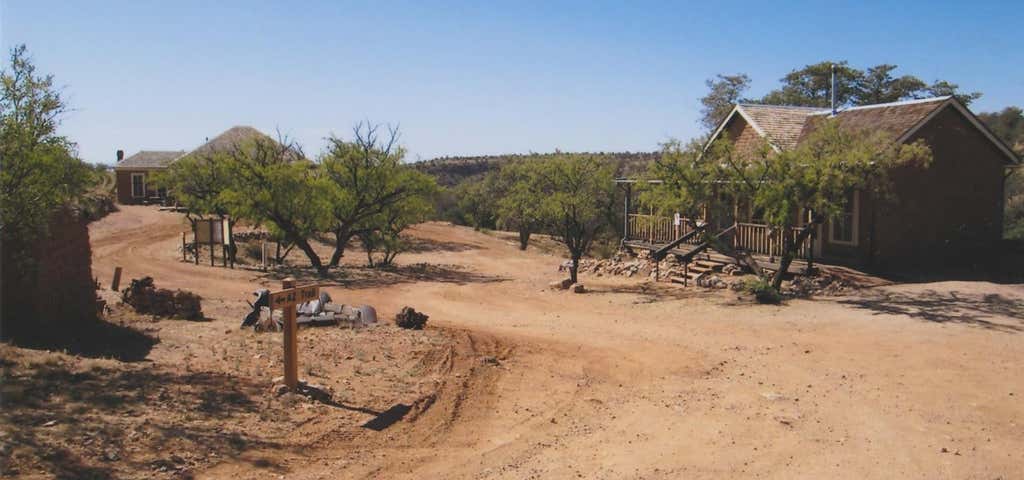This stretch of road, just above the Mexican border in southern Arizona, is home to some of the most beautiful and authentic ghost towns in the state. What were once prospering mining hubs have now succumbed to desertion and desolation. However, a number of dedicated individuals and organizations have worked hard to preserve these standing relics, making for some truly wonderful roadside adventures.
While Pearce is technically considered a small community in Cochise County, its more commonly known for its ghost town. Home to the famous Commonwealth Mine, Pearce was named after James Pearce, a miner and cattleman who discovered gold there in 1894. The Commonwealth Mine became one of Arizona's most success silver producers, generating more than 1,000,000 tons of ore from 1895 to 1942. But the town slowly started to decline in the 1930s, and then officially became a ghost town in the late 1940s. Today, visitors can walk down Pearce's abandoned main street, stop by the old jail house, and even step into the town's illustrious cemetery. Rumor has it that both Abraham Lincoln's body guard and General Sherman's assistant are buried there.
If you're looking for a place that packs history, activity, and all-around fun into one, then Courtland is the place for you. Nestled among the hills above Gleeson, this ghost town offers daily group tours, special rock hound experiences, and guided turquoise collections. Michael, who acquired the patented mining claims years ago and has worked endlessly to preserve the town, is both extremely friendly and knowledgeable. As part of Michael's tour, visitors can even go down into an old mining shaft, much like the original miners once did (hardhats and headlamps included). Dogs and kids are both welcome, as are motorhomes and RVs. For a small fee, Michael will often let people camp on the property.
Just down the road from Courtland, you'll find Gleeson's very own ghost town. While there are still remnants of the town's hospital, saloon, and school, the real gem is the Gleeson jail. Having been restored by new owners in the 1990s, the jail now houses Native American artifacts, old Western saddles, an original mining bunk, mining tools, and other fascinating antiques. The Gleeson jail is open to visitors the first Saturday of each month. Historian Glenn Snow is usually there to talk about Gleeson’s heydays and the area’s history—be sure to ask him about the former "jail tree." Gleeson is about 15 miles from Tombstone via a dirt road. It’s also accessible by a paved road off of Highway 191.
Listen closely and you might be able to hear the sound of children playing outside the schoolhouse... Full of tattered foundations and abandoned buildings, the most impressive structure in the Fairbank ghost town has to be the school. Built in the 1920s during the peak of town's mining success, the school helped educate some of the 15,000 residents and their children. Visitors are welcome to check out the schoolhouse, which has been refurnished and redesigned to look exactly like it did one hundred years ago. And don't forget to check out the small cemetery, which offers some spectacular views of the San Pedro Riparian National Conservation Area.
We should preface by saying that the Charleston and Millville ghost towns are not accessible by car, so gear up for a quick hike if you want to visit these historic townsites. Park along East Charleston Road, and take a short hike up along the San Pedro River—Charleston is on the west bank of the river and Millville is directly across on the east bank. Despite being separated by water, the two towns are directly linked in both history and community. Charleston was actually established as a settlement for people who worked in Millville and refined the silver that came from Tombstone. Unfortunately, when Tombstone flooded in 1886, both Charleston and Millville began to decline. Definitely a more rustic stop along the route, visiting the Charleston and Millville Historic Townsite will offer both history and a nice dose of nature.
Probably the most ghost town-like of all the places on our trip, Kentucky Camp is located within the confines of the Coronado National Forest and, therefore, is maintained and preserved by the U.S. Forest Service. This has helped keep the 340-acre plot clean, organized, and authentic. There are currently five complete structures on the property: two cabins, an office, a barn, and a gold processing building. Walking along the wide, dirt roads, looking at the fully restored buildings, you might feel like you've gone back in time and become a resident of the town. And even if you don't plan to stay long, the drive into Kentucky Camp is nearly worth the visit itself...
Housing more than 2,000 residents at its peak, the town of Harshaw had seven saloons, a boarding house, a hotel, multiple shops, even it's own post office and newspaper. But life in Harshaw was short and sweet. Just five years after its foundation, the town suffered a fire, as well as a dramatic drop in the quality of silver, and the majority of the population moved on. Today, there are just a few remnants left, most of which have crumbled and become overgrown. Not far from the Mexican border, Harshaw is a quiet, peaceful place not often frequented by visitors. Stop here to grab a breath of fresh air, stretch your legs, and reflect a bit on all the ghostly towns you've seen.
The next time you find yourself driving through Tucson, be sure to check out a few of these ghost towns. Remarkable representations of the past, these remote towns and structures will surely welcome you and allow you the opportunity to walk through Arizona's unique history.
Banner Photo Credit: Website
Visit Tucson
Tucson (pronounced TOO-sawn) is the second-largest city in the state of Arizona, with nearly one million residents in the metro area.








